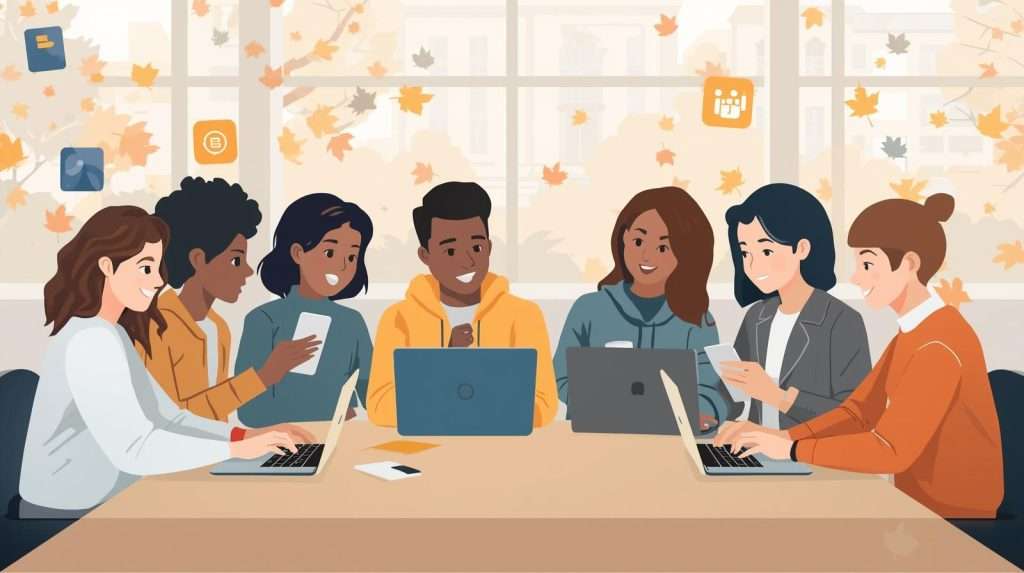There are thousands of apps shouting for your attention, but as a student in Ontario you only need a small toolkit that actually makes life easier. The right software can keep assignments organised, protect your budget, and even help with transit and mental health support. This page keeps it simple: no 200-item software list, just the tools most Ontario students actually use in 2025.
Domestic and international students can use it as a checklist when setting up a new phone or laptop before classes start.

Software for Students in Ontario
Before downloading everything in the app store, claim the software your school already pays for.
Email + productivity suite
Most Ontario colleges and universities provide access to Microsoft 365 Education (Word, Excel, PowerPoint, OneNote, OneDrive, Teams) or Google Workspace for Education (Docs, Sheets, Slides, Drive, Meet) at no extra cost if you have a valid school email. Always check your school’s IT services page to confirm what’s included for your programme.
Learning Management System (LMS)
Your courses will likely live inside Brightspace/D2L, Canvas, Moodle, or Blackboard. Install the matching mobile app so you can quickly check announcements, due dates, and grades instead of hunting through email.
Collaboration and video
Many programmes use Teams, Zoom, or Google Meet for online classes and group work. Install the one your instructors use and sign in with your school account so you’re not scrambling 5 minutes before a lab.
Campus-specific apps
Some schools offer their own app for campus maps, events, safety alerts, and printing. Search “[Your College] app” in the App Store/Google Play or on your IT services page.
15-minute “day one” setup
- Log into your school email in a browser.
- From there, claim Microsoft 365 or Google Workspace.
- Install your LMS app and turn on notifications for announcements and upcoming due dates.
- Install Teams/Zoom/Meet using your school login.
Those 15 minutes save you a lot of “I can’t open this file” panic later.
Core study tools — notes, readings, and citations
You don’t need fancy tools to be a strong student. You need one reliable place for notes, one place for files, and one way to handle citations.
Note-taking and course organisation
For most students, these cover almost every scenario:
- Microsoft OneNote – excellent with a stylus and free with many Microsoft 365 Education accounts.
- Notion – like a digital binder; great for combining notes, checklists, and group project boards.
- Apple Notes or Google Keep – quick capture for ideas, photos of the board, or reminders.
Simple structure that works:
- One notebook/workspace per term
- One section/page per course
- Sub-pages for lectures, tutorials, and exam review
The goal: at 11 p.m. before an exam, you know exactly where your notes live, not which pile of paper they’re in.
Reading, PDFs, and scanning
- Use Adobe Acrobat Reader, Preview (Mac), or Microsoft Edge to annotate PDFs.
- Install a scanner app (Microsoft Lens, Adobe Scan) so you never lose important paper. Scan lecture handouts and notebook pages, save them straight into OneDrive or Google Drive, and you can search your notes instead of digging through a backpack the night before the exam.
Citations and research
If you write essays or lab reports, a citation manager saves hours:
- Zotero (free, open source) for storing articles and creating reference lists.
- Mendeley or EndNote if your department suggests them.
A simple way to use it:
- Save each article or book chapter into Zotero as you find it.
- Tag it by course and assignment.
- Use the Word/Google Docs plug-in to insert citations and generate a bibliography in the right style (APA, MLA, etc.) instead of formatting by hand.
Time, tasks, and exam planning
Missing one deadline can snowball into a stressful term. Pick one calendar and one task tool and commit to them.
Calendar (big picture)
- Google Calendar or Outlook both sync across phone and laptop.
- Create separate calendars for Classes, Assignments & Exams, and Work/Life.
- At the start of term, enter all due dates from every course outline. It’s boring once, but it turns your calendar into a “don’t fail” radar.
Tasks (small steps)
- Apps like Todoist, Notion, or Microsoft To Do help break big assignments into smaller pieces.
- Label tasks in a way your tired brain understands: Today, This Week, Later plus course codes (e.g., “Today – MAT101 quiz review”).
Mini example – one essay
- Calendar: “HIS102 essay due – March 20, 11:59 pm”.
- Tasks:
- Choose topic (Mar 5)
- Find 5 sources (Mar 7)
- Draft outline (Mar 10)
- Write first draft (Mar 14)
- Edit and submit (Mar 19)
You’ve turned “big scary essay” into five doable evenings.
Read: Cheapest Phone Plans for Ontario
Money & budgeting apps that work in Canada
You don’t need Wall Street-level tools — just a clear view of what’s coming in and going out.
Start with your bank’s app
Every major Canadian bank (RBC, TD, Scotiabank, BMO, CIBC, etc.) has solid apps with:
- Account balances and spending summaries
- E-Transfer
- Alerts when your balance drops or a bill is due
For many students, simply checking this once a week prevents overdraft surprises.
Budgeting options
Popular choices among Canadian students:
- YNAB (You Need A Budget) – paid, but powerful if you like detailed envelopes and long-term planning.
- Monarch Money – paid, all-in-one tracking with a cleaner design.
- KOHO – a prepaid Visa + app with no typical credit card interest and built-in spend tracking.
- A simple spreadsheet in Google Sheets or Excel — completely free and easier to customise than any app.
Read: Renting First Apartment in Ontario
Sample monthly budget (smaller Ontario city)
Example: Mohawk College student in Hamilton, sharing a 2-bedroom with a roommate in 2025:
- Rent + utilities (your share): $900
- Phone + internet share: $80
- Groceries: $250
- Transit (PRESTO/bus pass): $150
- Eating out / coffee: $120
- Miscellaneous / textbooks / printing: $100
Total: $1,600/month.
That $900 share assumes a modest shared place; average one-bedroom rents in Hamilton are around the mid-$1,600s in recent reports, so splitting a 2-bedroom or renting a room in a shared house is common.
Reality check for GTA: In Toronto, recent data puts average one-bedroom rents roughly around $2,000+/month in 2025, so your share in a shared place could easily be $1,200–$1,800 depending on location. Adjust the numbers to your city, housing type, and whether you’re on or off campus.
The point isn’t perfect accuracy — it’s giving yourself a monthly “map” and checking it weekly so problems don’t sneak up on you.
Getting around — transit and maps in Ontario
If you’re in the GTA, Hamilton, Ottawa, or surrounding areas, the PRESTO card and app are almost unavoidable:
- The PRESTO app lets you load funds, buy passes, and check your balance from your phone. It works with TTC, GO Transit, MiWay, YRT/Viva, Brampton Transit, HSR, Oakville Transit, Durham Region Transit, OC Transpo (Ottawa), and more.
Pair PRESTO with:
- Transit or Rocketman for real-time bus and streetcar arrivals.
- Google Maps or Apple Maps for walking and transit directions (including delays and transfer times).
Smaller towns often have their own apps or websites. Search “[Town name] transit” and add a shortcut to your home screen.
For community and newcomer services (housing help, food banks, language classes, legal clinics, etc.), save 211:
- In Ontario you can call 2-1-1 or use the search tools at 211Ontario.ca or 211.ca.
- There is also an official 211 Canada mobile app for iOS and Android that lets you search for help and services anywhere in the country.
Read: Student transit discounts in Ontario (PRESTO, GO, TTC, VIA)
Health, safety, and wellbeing tools
These tools don’t replace medical care or emergency services, but they give you faster access to support.
Good2Talk (Ontario & Nova Scotia)
Good2Talk is a free, confidential, 24/7 support service for post-secondary students in Ontario and Nova Scotia. It’s funded by the provincial governments and delivered through a partnership of ConnexOntario, Kids Help Phone, 211 Ontario, and the Knowledge Institute on Child and Youth Mental Health and Addictions.
For Ontario students, you can:
- Call 1-866-925-5454
- Text GOOD2TALKON to 686868
- Use web chat from the Good2Talk Ontario site
They can offer immediate support and connect you to on- and off-campus resources.
211 Ontario
As above, 211 is a free, confidential helpline and online database that connects Ontario residents to local social, health, and community services. Trained information and referral specialists help you find the right resource — you don’t need to know what to ask for or what the programme is called.

Campus safety apps
Many Ontario campuses provide their own “Campus Safety” or security apps that include:
- Emergency contact buttons
- Walk-safe services
- Alerts about closures or safety issues
Save these before you ever need them. In any immediate emergency, call 911 first, then campus security.
Privacy and security — protect your accounts
With so many logins, a bit of security software is non-negotiable:
- Use a password manager (1Password, Bitwarden, or your browser’s manager) instead of re-using the same password.
- Turn on two-factor authentication (2FA) for email, banking, and school accounts using an authenticator app.
- Keep assignments in cloud storage (OneDrive/Google Drive) and occasionally back up major projects to a USB drive. Future-you will be very grateful when your laptop decides to die in week 10.
First-week setup checklist for new Ontario students
Use this as your quick reference:
- School tools
- Log into school email.
- Set up Microsoft 365 or Google Workspace if offered.
- Install LMS + Teams/Zoom/Meet.
- Study system
- Choose one main note app (OneNote/Notion).
- Set up course folders and a simple naming system.
- Install a scanner app and, if you write essays, a citation manager.
- Time & tasks
- Choose one calendar and add class times + deadlines.
- Choose one task app and create “Today / This Week / Later” lists.
- Money & transport
- Install your bank app and enable alerts.
- Pick a budgeting method (app or spreadsheet) and plug in your monthly targets.
- Get a PRESTO card (if in a covered area) and install the app or bookmark your local transit site.
- Wellbeing & safety
- Add Good2Talk and 211 contact details to your phone.
- Install your campus safety app if available.
- Save important numbers (family, landlord, workplace, clinic).
Read: How to become a travel agent in Ontario
Key takeaways
- You don’t need 50 apps — just a lean, reliable toolkit you actually use.
- Claim school-provided software first; many students get Microsoft 365 or Google Workspace for free.
- Use tools that actually work in Canada and Ontario for banking, budgeting, and transit (PRESTO, 211, local transit apps).
- Save Good2Talk and 211 before you’re stressed so support is one tap away.
- Protect your work with a password manager, 2FA, and cloud backups — and keep your system as simple as you can.


